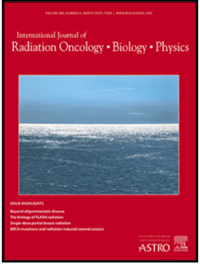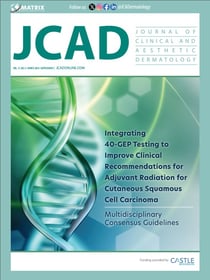
New publication Future Oncology confirms DecisionDx-SCC identifies high-risk SCC patients who benefit most from adjuvant radiation therapy
DecisionDx-SCC has now been independently validated to predict ART treatment benefit in two studies comprising over 1,300 patients. Together, these two studies by Ruiz et al. in Future Oncology (2024) and Arron et al. in the Red Journal (2024) represent the largest published population of ART-treated high-risk SCC patients. Results from this study provide a validation of the performance of the previously reported (Arron et al. Red Journal 2024) benefit of ART for Class 2B tumors and a lack of benefit for Class 1 tumors and was conducted using 423 tumors from 399 patients from Brigham Women’s Health (BWH) and Cleveland Clinic. Given the consistency of the results from two independent cohorts, DecisionDx-SCC can aid in ART decision-making for patients with high-risk SCC tumors.
Key Findings:
-
Select patients with completely resected high-risk squamous cell carcinoma are eligible for and undergo adjuvant radiation therapy (ART), but criteria for ART is heterogenous. -
Identifying patients with the highest risk of disease progression who would most benefit from ART is a clinical challenge. -
The 40-gene expression profile (40-GEP) test was recently reported to predict a benefit from ART for patients receiving a Class 2B result, and a low likelihood of benefit for a Class 1 result that together with low metastatic risk suggests these patients may consider deferring treatment. -
This validation study utilized an independent cohort of patients with high-risk cutaneous squamous cell carcinoma tumors matched on clinicopathological factors to compare disease progression rates and projected time to metastasis (using a “life expectancy” algorithm) for patients who received ART to those who did not. -
Patients with a 40-GEP Class 2B result showed a median ∼50% decrease in disease progression between ART-treated and untreated tumors and a significant deceleration in projected time to metastases. No differences were observed for Class 1 between ART treated and untreated tumors. -
The results validate the 40-GEP test as having predictive value in identifying patients benefitting from ART and those that can safely defer, and can guide difficult management decisions when patients and their physicians are considering the risks of side effects and benefit of ART. Previous work has shown that deferring ART in 40-GEP Class 1 patients can save $784 million annually in direct healthcare costs.
Read the article here.
.jpg?width=457&height=650&name=ifon_a_2390820_f0002_c%20(1).jpg)
New Publication Shows DecisionDx®-SCC Identifies High-Risk Squamous Cell Carcinoma Patients Who Are Likely to Benefit from Adjuvant Radiation Therapy and Those Who Can Consider Deferring Treatment Based on Biological Risk of Metastasis
Read the article here.

Key findings of the study (n=920 patients) include:
- The DecisionDx-SCC test identified patients projected to receive the greatest benefit from ART to reduce metastatic disease progression. Patients with a Class 2B (highest metastatic risk) test result who were treated with ART had 50% higher MFS rates, on average, than Class 2B patients who did not receive ART at five years post-diagnosis
- A DecisionDx-SCC Class 2B result was the only independent risk factor that successfully identified patients who would most benefit from ART. Risk factors in the analysis included differentiation status, invasion into fat, perineural invasion and others, including National Comprehensive Cancer Network (NCCN) risk category and Brigham and Women's Hospital and American Joint Committee on Cancer Eighth Edition T-stages
- Class 2B patients who received ART showed a significant deceleration in disease progression compared to Class 2B patients who did not receive ART. For patients with a DecisionDx-SCC Class 2B test result who were not treated with ART, there was a peak rate of metastasis around two years; Class 2B, ART-treated patients had nearly five times longer projected time to metastasis
- DecisionDx-SCC identified patients who were less likely to show a significant benefit from ART in controlling disease progression. Patients with high-risk clinicopathologic features but who received a DecisionDx-SCC Class 1 (lower metastatic risk) test result did not show a significant benefit from ART. Given the low risk of metastasis for Class 1 patients, in addition to the lower likelihood of ART benefit, Class 1 patients may consider deferring treatment
New publication: Integrating 40-GEP Testing to Improve Clinical Recommendations for Adjuvant Radiation for Cutaneous Squamous Cell Carcinoma
Integrating DecisionDx-SCC 40-GEP testing improves precision in multidisciplinary treatment recommendations for ART, imaging, and the risk/benefit analysis for these interventions when applying the Class results of the test.

- Three clinical practice gaps emerged during the consensus discussion for which the panel members agreed that the addition of 40-GEP testing has significant clinical utility:
- In escalation of care for lower-stage patients with high-risk tumors
- In de-escalation of care for patients for whom the risks of ART may outweigh the benefits
- In decision-making regarding elective radiation to the nodal basin
- The expert panelists also agreed with a report from a recent survey of members of the multidisciplinary Skin Cancer Outcomes (SCOUT) consortium that recommended ART be considered when risk of metastasis is 20% or higher
- There was agreement that a Class 2A or 2B result serves as a high or very high-risk feature for consideration in recommending ART, as the metastatic risk conferred by these two results is similar to those of poor differentiation and PNI
- For multi-disciplinary care, panelists agree that dermatologists should image these Class 2A and 2B patients and refer them to radiation oncology, with a recommendation for multidisciplinary tumor board discussion for patients with Class 2B results
- Radiation oncologists should discuss individual risks and benefits of radiation with all of their patients and integrate Class 2A and 2B results into the context of other high-risk features when considering radiation, with a stronger recommendation of ART for Class 2B patients
- Panelists also recommend imaging by the physician’s choice of preferred modality in SCC patients with 40-GEP high-risk Class 2A or 2B results
- Consensus was also reached that imaging is preferred over sentinel lymph node biopsy (SLNB), given the absence of clear benefit and the possible morbidity of that procedure
